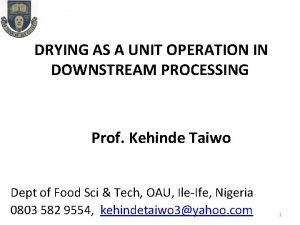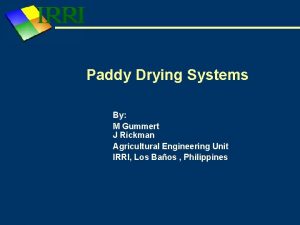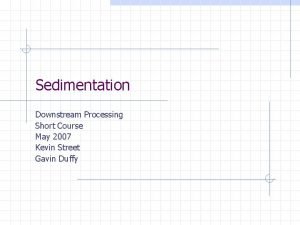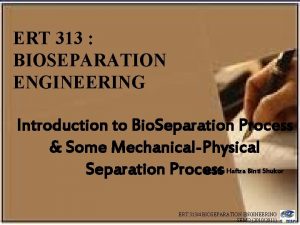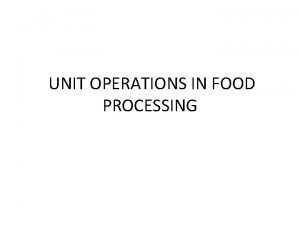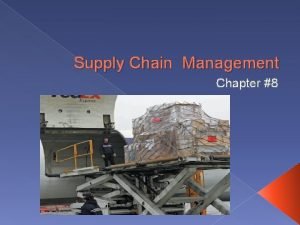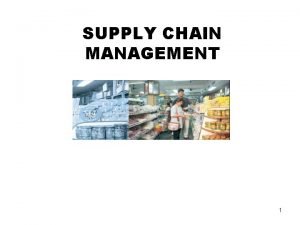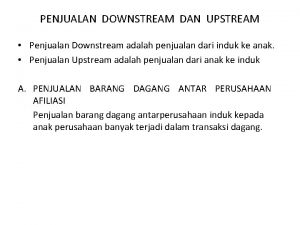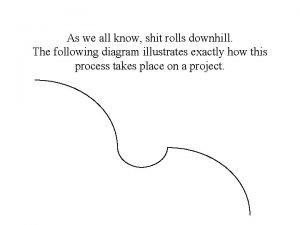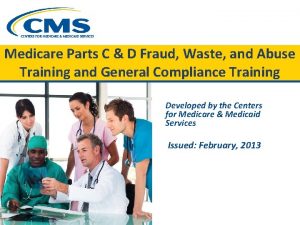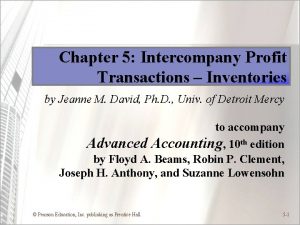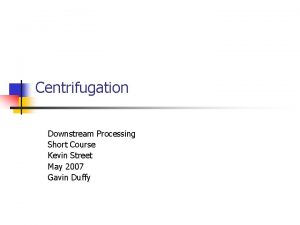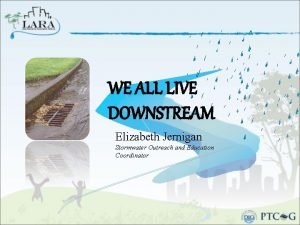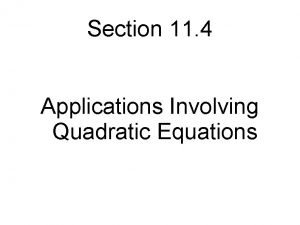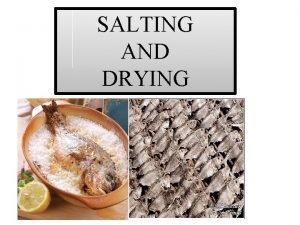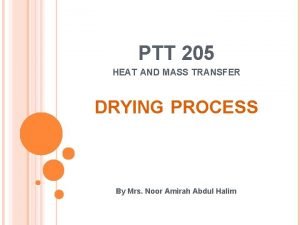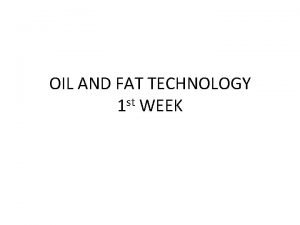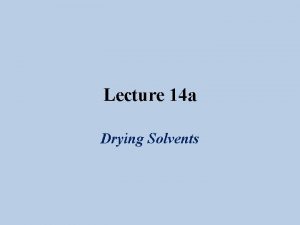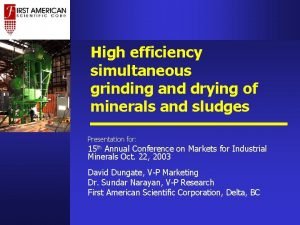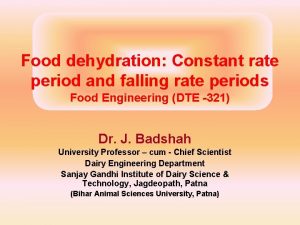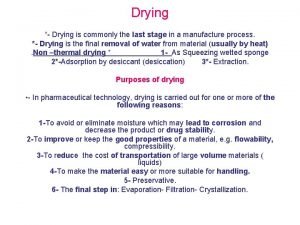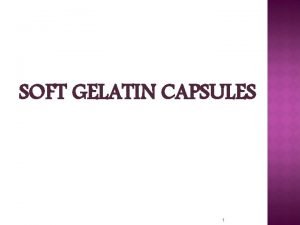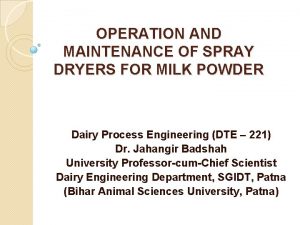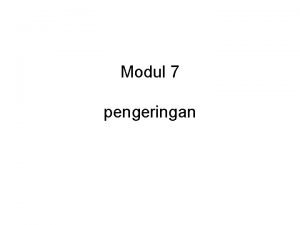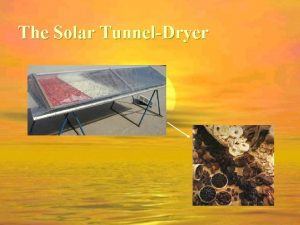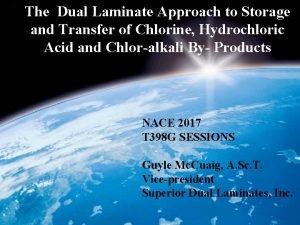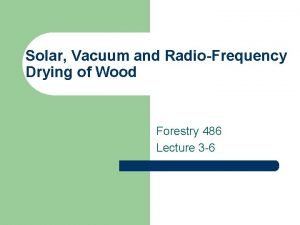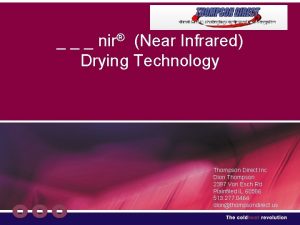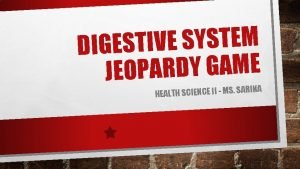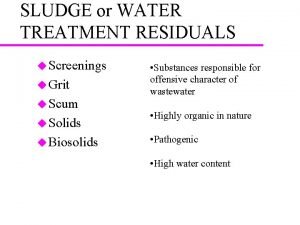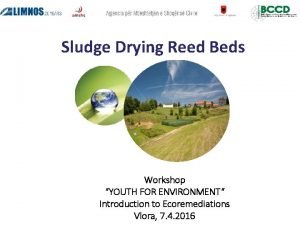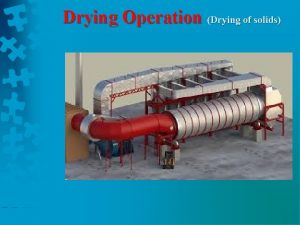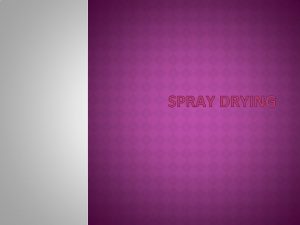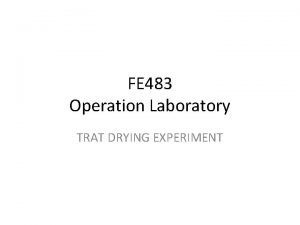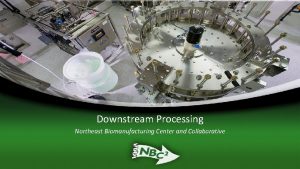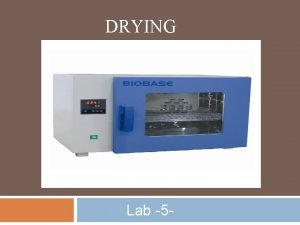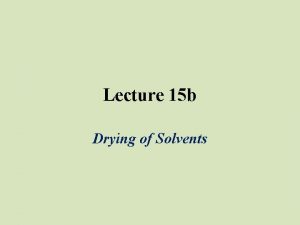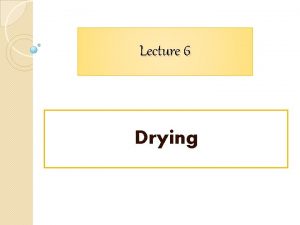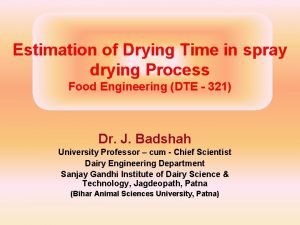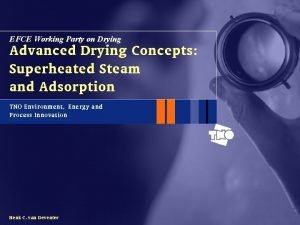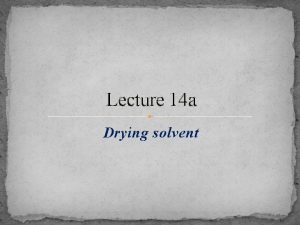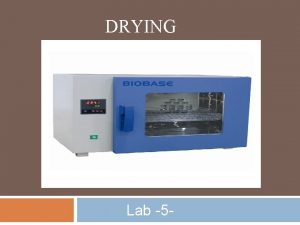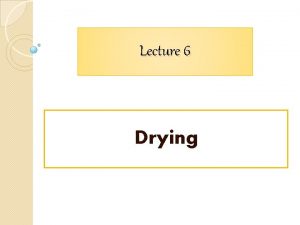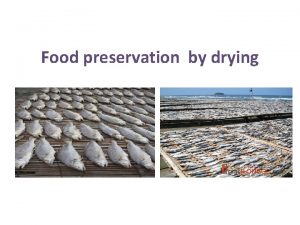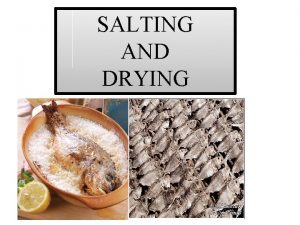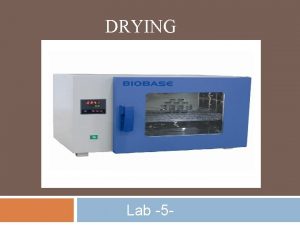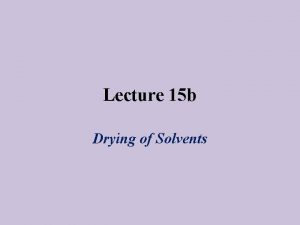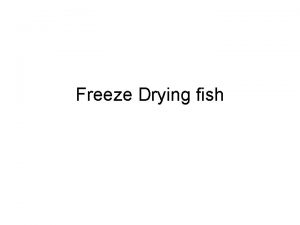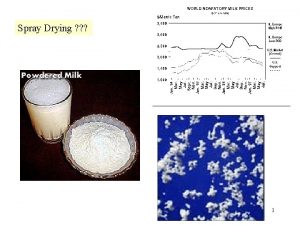DRYING AS A UNIT OPERATION IN DOWNSTREAM PROCESSING

















































- Slides: 49

DRYING AS A UNIT OPERATION IN DOWNSTREAM PROCESSING Prof. Kehinde Taiwo Dept of Food Sci & Tech, OAU, Ile-Ife, Nigeria 0803 582 9554, kehindetaiwo 3@yahoo. com 1

rd 3 • • International Conference on Bioprocess & Engineering Double Tree by Hilton Baltimore, Maryland, USA 14 & 15 Sept. 2015 organised by OMICS Group Conferences

Introduction • All foods and biomaterials need some form of preservation to – Reduce or stop spoilage – Make them available throughout the year – Maintain desired levels of nutritional and bioactive properties for the longest possible time span and – Produce value added products

Downstream processing • Refers to the recovery of biomolecules from natural sources such as animal or plant tissues besides fermentation broth • It is an essential step which determines final cost of the product in the manufacture of biomolecules e. g. – Antibiotics, vaccines, antibodies, – Hormones (e. g. Insulin and human growth hormone) – Antibodies (e. g. Infliximab and abciximab), enzymes, and – Natural fragrance and flavor compounds

Drying • Air-drying is an ancient preservation method • Foods are exposed to a continuously flowing stream of hot air • It involves simultaneous mass and heat transport • Moisture availability has a great impact on the transfer of heat to microorganisms • Consumer demand has increased for processed products that keep more of their original characteristics

Drying Methods • This requires the development of operations that minimize the adverse effects of processing • There have been various advances in the drying of foods with respect to quality, rehydration, and energy minimization • Some of the improvements and advancements made leading to the new developments in drying are discussed

Intermittent batch drying • By varying the operating conditions of a drying process – Airflow rate – Temperature – Humidity or – Operating pressure • It can be monitored in order to reduce the operating cost e. g. thermal input and power input

Intermittent batch drying • The objective is to obtain high energy efficiency without subjecting the product beyond its permissible temperature limit and stress limit while maintaining high moisture removal rate

Hybrid drying techniques • May include either use of – More than one dryer for drying of a particular product (multi-stage drying) – More than one mode of heat transfer – Various ways of heat transfer or – Multiprocessing dryers

Hybrid drying techniques • For particulate drying – Variants of fluid bed or – Fluid bed with some other techniques can be used in series to achieve faster drying • For liquid feedstock – Generally spray drying is followed by the fluid bed dryer • To reduce moisture content to an acceptable level which is not possible by spray dryer alone

Modified atmosphere drying • The presence of oxygen results in various unwanted characteristics in dried food materials – oxidation of the drying material – destruction of its bioactive compounds – browning • O 2 can be replaced by N 2 or CO 2 • In addition, it increases the effective moisture diffusivities of some food products

Superheated steam drying • Superheated steam does not contain oxygen, hence oxidative or combustion reactions are avoided • It also eliminates the risk of fire and explosion hazard • It allows pasteurization, sterilization and deodorization of food and bio-products • Net energy consumption can be minimized if the exhaust (also superheated steam) can be utilized elsewhere in the plant and hence is not charged to the dryer

Impinging stream drying • In Impinging stream dryers • The intensive collision of opposed streams create a zone that offers very high heat, mass and momentum transfers • Hence rapid removal of moisture from surface • Other advantages - low foot prints and high robustness due to absence of moving parts • Effective alternatives to flash dryers for particulate materials with very high drying loads

Contact sorption drying • The contact-sorption drying can be achieved by • 1) contacting a wet material with heated inert particles, thereby removing the moisture as a result of heat exchange or • 2) contacting of wet material with heated sorbent particles where the moisture is transferred from wet solids to the sorbent particles

Contact sorption drying • A typical contact-sorption drying technique involves good mixing of wet solid particles with the sorbent particles to achieve the heat and mass transfer and then separation of these two media • The sorbent particles are regenerated and returned back to the dryer • The typical inert sorbent particles (also called a carrier) are molecular sieves, zeolites, activated carbon, silica gel, etc.

Heat pump-assisted drying • Heat pump dryers use low temperature dehumidified air as the convective drying medium • It incorporates a dehumidification cycle, where condensation of water allows the removal of water from the closed system of drying air circulation • The heat pump recovers the sensible as well as latent heat by condensing moisture from the drying air • An auxiliary heater is generally added for better control of the temperature at dryer inlet

Radio frequency drying • Dielectric heating is the use of either microwave or radio frequency (RF) technologies to heat materials • Microwave and RF interact with individual molecules to quickly generate heat within a product • This is in contrast to conventional heating where heat is applied externally • A wet product submitted to a RF field absorbs the electromagnetic energy, so that its internal temperature increases

Radio frequency drying • If sufficient amount of energy is supplied, the water is converted into steam, which leaves the product; and gets dried • The amount of heat generated in the product is determined by the – Frequency – Square of the applied voltage – Dimensions of the product and – The dielectric "loss factor" of the material which is essentially a measure of the ease with which the material can be heated by this method

Microwave drying • Microwave oven has ability to heat food products rapidly, conveniently and economically in a compact space • The primary drawback is its inability to heat materials in a predictable and uniform manner leading to • -hot spots that damage the item being heated • - cold spots - under heated or under processed, thereby compromising product quality and repeatability • Microwave heating in combination with vacuum has been used extensively for drying in pharmaceutical processing

Drying in Downstream Processing • Process industries manufacture different products from a variety of raw materials • The raw materials are pretreated and conversion takes place in a reactor and separation of product of interest and its purification takes place in subsequent steps • All the steps that are prior to the reactor form “upstream processing” • All the steps after the reactor form “downstream processing”

Drying in Downstream Processing • In all the unit operations involved in downstream and upstream processing only physical changes occur and do not involve chemical changes • Unit operations for separation and purification during downstream processing include: – distillation, – extraction, – drying, – evaporation absorption, crystallization, mixing,

Downstream Processing Vs Analytical Bioseparation • Both refer to the separation or purification of biological products, but at different scales of operation and for different purposes • Downstream processing implies manufacture of a purified product for a specific use in marketable quantities • Analytical bioseparation refers to purification for the sole purpose of measuring a component or components of a mixture, and may deal with sample sizes as small as a single cell

Complexity Of Downstream Processing • Two factors • 1) the desired product is generally present in low concentrations and • 2) it is present along with several impurities or undesired components • The economics of downstream processes are determined by the required purity of the product which in turn depends on the applications of the product. • As a result downstream processing mostly contributes 40 -90 % of total cost

Applications in Downstream Processing • Thermal drying is more expensive than mechanical dewatering • For dehydration of the biomass after harvest – Thermal drying should be preceded by a mechanical dewatering step such as filtration or centrifugation • Harvesting generally results in a 50 to 200 -fold concentration of biomass • The harvested biomass slurry (5– 15% dry solids) must be processed rapidly, or it can spoil within a few hours in a hot climate • The specific postharvest processing necessary depends strongly on the desired product

Applications in Downstream Processing • Membrane processes such as microfiltration, ultrafiltration and reverse osmosis – the recovery and concentration of microbial cells/biomolecules – enable volume reduction of slurry/solution before downstream processing operations (chromatography, electrophoresis, freezing or freeze-drying ) • Drying methods include spray drying, drum drying, freeze-drying and sun drying

Additives/Carriers/Transporters • Use of additives offer protection to microorganisms during drying • The choice of an appropriate carrier is important to increase their survival rates during dehydration and subsequent storage • Differences exhibited are related to their waterbinding capacity and prevention of intracellular and extracellular ice crystal formation • Additive materials increase the glass transition temperature and result in a dried product with increased stability and less hygroscopicity • The characteristics of the transporters involved in sugar uptake lead to differences in their performance

Carriers/transporters • Protein (whey protein, skim milk) • Mrs-broth-based protectants • Sugars (e. g. maltodextrin, glucose, fructose, lactose, mannose and sucrose) • Sugar alcohols (e. g. sorbitol and inositol) • Non-reducing sugars (e. g. trehalose) • Disaccharides give better viabilities after freeze-drying than monosaccharides

Fig 1. Schematic diagram of a spray-drying process

Spray Drying - Advantages • Used to dry thermo-sensitive bioactive compounds and probiotics • Increases surface to volume ratio of the liquid particles and consequently enhance the heat and mass transfer during the drying process • Continuous operation • Short time of contact with hot air • Drying taking place at wet bulb temperature • Process larger volumes and operate at higher energy efficiency

Spray Drying • Allows preparation of stable and functional powder products • Can be implemented for large scale throughputs • Main disadvantages • High installation costs • Removal of aromatic volatiles • Prone to damaging heat sensitive components such as enzymes and probiotic bacteria

Process conditions • • in spray drying Air inlet temperature Feed flow rate Feed formulation Out let air temperature and Nozzle pressure Affect Retention of activity of bioactive compounds Survivability of microorganisms

Process conditions • Low outlet temperature, lower residence time, low nozzle pressure - good enzyme activity retention and survivability of microorganisms has been observed • However, too low out let air temperature may result in higher residual moisture content leading to loss of viability and enzyme activity retention during storage

Selection of Dryers • Drying technologies have become more diverse and complex • Dryer selection has become an increasingly difficult task • The need to meet – Stricter quality specifications – Higher production rates – Higher energy costs and – Stringent environmental regulations

Selection of Dryers • Characteristics of different dryer types should be recognized when selecting dryers • Changes in operating conditions of the same dryer can affect the quality of the product • The dryer type & right operating conditions for optimal quality and cost of thermal dehydration

Selection of dryers • Drying of products require adherence to Good Manufacturing Practice and hygienic equipment design and operation • Drying kinetics play a significant role • Location of the moisture (whether near surface or distributed in the material) • Nature of moisture (free or strongly bound to solid) • Mechanisms of moisture transfer (rate limiting step)

Selection of dryers • Physical size of product • Conditions of drying medium (temperature, humidity, flow rate of hot air for a convective dryer) • Pressure in dryer (low for heat-sensitive products) • Demands on product quality may not always permit one to select the least expensive option based solely on heat and mass transfer considerations • In the drying of non-aqueous (organic) solvent or a mixture of water (pharmaceutical products) with a solvent, care is needed to recover the solvent and to avoid potential danger of fire and explosion

Classification of dryers Mode of operation Heat input-type State of material in dryer Operating pressure Drying medium Drying temperature Relative motion between drying medium and drying solids • Number of stages • •

Table 1 - Classification of dryers Criterion Mode of operation Types Batch Continuous* Heat inputtype Convection* Conduction Radiation Electromagnetic fields Combination of heat transfer modes Intermittent or continuous* Adiabatic or non-adiabatic

Table 1 - Classification of dryers Criterion State of material in dryer Operating pressure Drying medium (convection) Drying temperature Types Stationary Moving, agitated, dispersed Vacuum* Atmospheric Air* Superheated steam Flue gases Below boiling temperature* Above boiling temperature Below freezing point

Table 1 - Classification of dryers Drying temperature Below boiling temperature* Above boiling temperature Below freezing point Relative motion between Co-current drying medium and drying solids Counter-current Mixed flow Number of stages Single* Multi-stage Residence time Short (< 1 minute) Medium (1 – 60 minutes) Long (> 60 minutes) * Most common in practice

Drying system includes • Pre-drying stages • Post-drying stages

Drying system - Pre-drying stages • E. g. - – Evaporation Mechanical dewatering – Dilution Pelletization – Feeding Size reduction – Flaking Extrusion – Pre-conditioning of feed by solids backmixing with dry product

Drying system • • • - post-drying stages Exhaust gas cleaning Product collection Partial recirculation of exhausts Cooling of product Coating of product Agglomeration, etc. • The optimal cost-effective choice of dryer will depend on these stages

Over-drying • • Increases the energy consumption Increases drying time Can be avoided by Reducing the feed liquid content by less expensive operations such as – Filtration – Centrifugation and – Evaporation

Future Potentials and Challenges • Downstream processing of biological products has been affected by – The growth of the biopharmaceutical industry – Drastically changing purity expectations – Processing volume – Production flexibility to accommodate new products

Future Potentials and Challenges • A volume-reduction step should achieve high cell concentration, with minimal product loss or change in product quality even at large scale • Such high cell concentrations can be achieved with appropriately sized systems and consideration of system hold-up volume

Future Potentials and Challenges • Detailed knowledge on protein stability i. e. understanding of structural changes of biomolecules as a result of environmental influences can help in process design • The product bioavailability challenge is more related to improving solubility which may play an important role as it may promote super saturation • In the scale-up process control over particle size is a priority in spray drying

Conclusions • Drying of heat labile biological materials preserves activity of enzymes/cells during storage and stabilize the bulk product until it can be formulated • Drying becomes expensive unless the product is of high value and low volume • Suitable drying methods need to be selected depending on the value of the product

• Thank you
 Drying in downstream processing
Drying in downstream processing Advantage of panicle drying
Advantage of panicle drying Sedimentation in downstream processing
Sedimentation in downstream processing Ripp scheme
Ripp scheme Unit operations in food processing
Unit operations in food processing Unit process and unit operation
Unit process and unit operation Unit operation and unit process
Unit operation and unit process Order promising module of supply chain management
Order promising module of supply chain management Upstream downstream supply chain
Upstream downstream supply chain Contoh penjualan upstream
Contoh penjualan upstream Marketing channel structures
Marketing channel structures Vertical integration คือ
Vertical integration คือ Shit rolls downhill
Shit rolls downhill Downstream entity examples
Downstream entity examples Downstream entity examples
Downstream entity examples A boat traveled 336 miles downstream and back
A boat traveled 336 miles downstream and back Intercompany journal entries
Intercompany journal entries Downstream e upstream
Downstream e upstream Sigma factor centrifuge
Sigma factor centrifuge What does we all live downstream mean
What does we all live downstream mean Quadratic equation upstream and downstream
Quadratic equation upstream and downstream Dry salting
Dry salting Difference between drying and evaporation
Difference between drying and evaporation Saponification value
Saponification value Freeze drying solvents
Freeze drying solvents Simultaneous grinding and drying
Simultaneous grinding and drying Hygroscopic food examples
Hygroscopic food examples Principles of freeze drying
Principles of freeze drying Free moisture content
Free moisture content Capsule definition
Capsule definition Spray dryers for milk powder
Spray dryers for milk powder X2xc
X2xc Solar tunnel dryer for drying coconuts
Solar tunnel dryer for drying coconuts Frp dual lamination product
Frp dual lamination product What are the 5 stages of clay
What are the 5 stages of clay Rf timber dryer
Rf timber dryer Is chopping a tree a chemical change
Is chopping a tree a chemical change Drying technology
Drying technology The three subdivisions of the small intestine are ________.
The three subdivisions of the small intestine are ________. Lyophilization process steps
Lyophilization process steps Sludge drying beds
Sludge drying beds Sludge drying reed beds
Sludge drying reed beds Another word for freeze drying
Another word for freeze drying Unit 10, unit 10 review tests, unit 10 general test
Unit 10, unit 10 review tests, unit 10 general test Bottom-up processing examples
Bottom-up processing examples Gloria suarez
Gloria suarez Bottom-up processing example
Bottom-up processing example Neighborhood processing in digital image processing
Neighborhood processing in digital image processing Primary and secondary processing of food
Primary and secondary processing of food Image enhancement point processing techniques
Image enhancement point processing techniques
